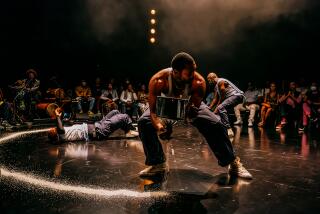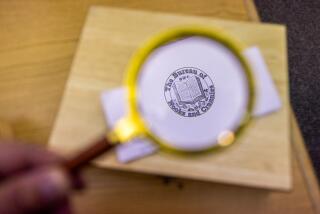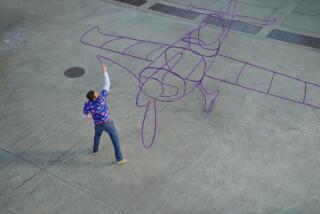‘Arrietty,’ ‘The Borrowers’ and the appeal of all things small
Kids — tykes, urchins, tots, moppets, bambinos, waifs, ragamuffins, cherubs and small fry — are fascinated by smallness. Consider their films: “Antz,” “A Bug’s Life,” “Honey, I Shrunk the Kids,” “Toy Story,” “The Rescuers,” “The Secret of NIMH,” “Snow White and the Seven Dwarfs,” “Stuart Little” and countless others. Indeed, a nod to the diminutive seems nearly obligatory if titles of children’s stories are any measure: “Little Red Riding Hood,” “Little Women,” “Little House on the Prairie,” “The Little Prince,” “The Little Engine That Could,” and so on. Now comes “The Secret World of Arrietty,” a tale of the tiny.
With a screenplay by anime genius Hayao Miyazaki (“Ponyo,” “Spirited Away,” “Howl’s Moving Castle”) and produced by his Studio Ghibli, “Arrietty” was the highest grossing film in Japan in 2010. When it was released elsewhere, it was warmly received by reviewers, who praised its visual artistry in an era in which others have turned to 3-D effects. Now with English-speaking voices (among them Amy Poehler, Carol Burnett and Will Arnett), the animated feature is being released in the U.S. this week by Disney.
Depending on how you count, “Arrietty” is either the fourth or fifth film based on the classic children’s book about smallness, “The Borrowers,” and in spirit, it is a fairly faithful rendition of Mary Norton’s 1952 novel. The story concerns 6-inch-high people who live a secret existence underneath the floorboards of a country home. They are called “Borrowers” because they borrow (blotting paper for rugs, postage stamps for wall paintings, chess pieces for statuary) from the big people upstairs, a race of conventionally sized folks they call “human beans.”
Norton’s fantasy primarily concerns one family of Borrowers, the Clocks: Arrietty (a plucky 14-year-old girl), Pod (her enlightened father, who, despite her gender, takes his only child on his foraging expeditions) and Homily (her fearful mother, whose anxiety about their precarious existence amounts to the dominant tone of the book).
The great danger of a Borrower is “being seen” by big people. As it happens, Arrietty is seen on one of her expeditions and eventually enters into a secret friendship with the Boy (called Shawn in the film), someone who brings Golden Days to the minuscule Clock family by providing purloined dollhouse furniture and other treats (note: a sugar cube can satisfy a village). Nonetheless, dangers abound in the form of a cat, a snoopy housemaid and ultimately a pest control firm.
Since the book’s publication, it has become a parlor game among critics to suggest whom the Borrowers represent. If inspired by her memories of World War II, Norton’s vulnerable people may picture the British sheltering from German bombers and taking refuge in the country. Or given their shrinking numbers and their penchant for borrowing, Norton’s creatures may be stand-ins for the Travelers, that gypsy-like race still found along the byways of England and Ireland. Or the answer may be simpler: Norton’s homunculi may really present the situation of kids in a world of towering adults.
Kids understand how size correlates with power. Adults talk over their heads. At McDonald’s, they can’t see over the counter to order and they can’t pay for a meal with their own credit card. Indeed, restaurants kindly provide high chairs and booster seats in the same way they provide wheelchair access. When Tom Hanks magically changes from a kid into an adult and gets his own apartment and a job on Madison Avenue, the movie is called “Big.” Likewise linking size and power, billionaire Leona Helmsley famously said, “Only the little people pay taxes.”
That’s not to say small fry can’t take advantage of their size. That rascal Peter Rabbit goes places where the portly Mr. McGregor can never pursue him. The diminutive Stuart Little does a favor by slipping into a sink drain to recover a lost wedding ring. And Tom Thumb and Jack (once he climbs the beanstalk) are tricksters who have their way with the humongous.
But when it comes to power, nothing reveals the childhood fascination with smallness so much as the appeal of the microcosm. The dollhouse, the toy theater, the action figures on the rug — there is an impulse at work in the early years to replicate the world in miniature and then tower over it. This may explain, incidentally, the appeal of Legoland, where, with its 20-to-1 scale, even a tot can feel like King Kong looming over a replica Empire State Building.
Musing on this topic of scale, Robert Louis Stevenson wrote that everyone who can remember childhood, watching ants and other insects, “must remember laying his head in the grass, staring into the infinitesimal forest and seeing it grow populous with fairy armies.” Of course, it’s just a tiny step from there to “Gulliver’s Travels,” where an Englishman lying on a grassy sward is trussed up by Lilliputians.
This is the world the Borrowers inhabit: where a drop of water is a pending threat to those below, where a ticking clock causes the floor to vibrate and where tissue paper is stiff and loud. It is the same world where Hans Christian Andersen’s Thumbelina is “pelted” by a snowflake and where E.B. White’s mouse-sized Stuart Little must manhandle a straw when proffered a drink. A change of scale makes us see the ordinary with different eyes.
Here lies the secret behind “The Borrowers”: Mary Norton was nearsighted as a child and wasn’t diagnosed until she went to boarding school. Later, talking about herself in the third person, Norton confessed that recalling her life before glasses made it easier for her to imagine a race of tiny people, living close at hand and among the ants: “She saw through their eyes the great lava-like (sometimes almost steaming) lakes of cattle dung — chasms to them, whether wet or dry. It would take them, she thought, almost half an hour of tottering on ridges, helping one another, calling out warnings, holding one another’s hands before, exhausted, they reached the dry grass beyond.
Nearsightedness is a kind of image for childhood’s fascination with smallness. The young pay attention to things close at hand. Nearing 90 years old, poet John Masefield looked back at his youth and recalled how he could spend hours looking into his box of toy soldiers and marbles. The young and the old, Masefield insisted, see the world differently: “The child knows his mile, or at most his two miles, better than a grown-up knows his parish.”
There are implications to this. Because the young see the world differently, implicitly, their points of view challenge the unquestioned and consensual values of adults. One day, Stuart Little serves as a substitute teacher and asks his tiny charges what’s really important in life. The kids do not mention wealth or fame or even, say, upcoming elections. They agree that what’s really important in life is “the way the back of a baby’s neck smells.” Who’s to say they’re wrong?
Griswold is the former director of the National Center for the Study of Children’s Literature. His most recent book is “Feeling Like a Kid.”
More to Read
The biggest entertainment stories
Get our big stories about Hollywood, film, television, music, arts, culture and more right in your inbox as soon as they publish.
You may occasionally receive promotional content from the Los Angeles Times.










